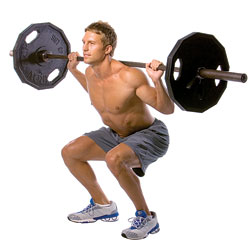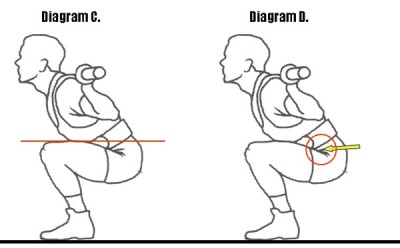Sæl!
Jesus, what a busy week on the site, eh? For all of you new readers, welcome. You probably came here because you thought there were gonna be hot babes or you wanted to argue with me. That’s fine. This website will entertain you (albeit poorly), but it’ll also aim to educate. Regardless of your training goals, there are gems you can glean for your mechanics, mobility, programming, nutrition, health, sleep, strength training, conditioning, powerlifting, Olympic weightlifting, and more. It won’t all come at once, because that’d be an information grenade that would make your head explode (and not necessarily the head on your shoulders).
PR Friday
Every Friday we post about our training personal records (PRs) in the comments. If PRs weren’t achieved, then readers can at least update everyone on their training. Posting regularly means that other people remember you and enjoy hearing about you; it helps them stay motivated as well. Join the fun.
Weekly Challenge
This is where I pose a challenge for readers to complete. Last week I actually forgot to write something and included a .gif that basically said, “Don’t suck.” Woops.
Next Week’s Challenge: Perform these foot drills every day in the next week. It should help those of you with lower extremity issues, but let’s see if it does anything else. You can do it prior to lifting and running.
Week In Review
Oh boy. The week started quietly with a post about the New England Women of Strength. Then things got interesting on the subject of treating very simple neural issues. Then things got kinda rowdy. Mark Sisson linked to the site; he runs Mark’s Daily Apple, an enjoyable website about health, nutrition, and primal living (Mark: Do you ever read fiction? My gods, man!). However, in conjunction with that I wrote a post about not needing sexy programming or equipment in training, but at the same time making a point about superficial websites that focus on selling “sexy” things, like pictures, slogans, memes, or catchy phrases instead of content with substance. The following day I pissed off a bunch of runners because I’m not impressed with completing a marathon. I’ll be honest, I only read the first half of the 80 or so comments. I get bored of the same, “Well, why don’t YOU do a marathon, tough guy,” comments over and over, which only prove my original point. I don’t enjoy people who get offended easily.
Q&A
This is the one day of the week where I pick a few questions from the Facebook Fan Page, Twitter, comments, or other messages and answer them. It keeps me on my toes, and I don’t know the answer I have a lot of friends who are smarter than me that I can ask.
Justin,[spoiler]
More of a lurker, but I’ve been following 70sbig since the beginning. After reading your marathon post today, I felt compelled to tell you how utterly awesome that was. Please write a history book describing significant battles and “athletic events worth emulating” in the same way as you have done today.I recently bought the TM Part 1 e-book and have been debating whether or not to buy Part 2. Heading over to the 70sbig store after I send this to you to pick it up. The quality of information you put out is some of the best in the fitness community and it dawns on me that I need to do my part to support you in this so you can continue to do it for a long time.Enough ass-kissing, just wanted to say thanks.[/spoiler]
While I’m at it, I’ll throw out a question. I’m a pretty tall dude at 6’5 with a very short torso relative to my long femurs. Current bodyweight around 215. Current 5RM low bar squat around 315. All time best is 360×5 at 240 lbs bodyweight. However I can deadlift mid 400’s for a set of 5 (all time best 500×5 at 240 lbs). Squatting is just a very difficult movement, and anything above 225 feels slow as shit; while deadlifting feels completely natural. Is there a certain type (low, high, front, etc.) of squat a guy in my situation should focus on? Goals are general athleticism for basketball, jackedness, but would also like to hit a 400 lb squat in a powerlifting meet.I recently dropped some excess bodyfat, so I’m back on an LP for a few weeks and then will transition to TM. I’ve read your posts about low bar vs. high bar squatting and you’ve addressed this in your Q&A before, but was just wondering if there were any special considerations/recommendations for a tall guy with long legs? Just continue driving up my low bar squat 2x/week?Thanks man,
Tim
Dear Tim,
As you know, I’ve talked at length on high bar and low bar squatting. To simplify:
Powerlifting: low bar
Weightlifting: high bar
GPP/S&C: Kinda doesn’t matter, but whichever suits goals best
Guys with your body type — long femurs and a short torso — have difficulty with the vertical style squats (high bar and front) because of the angles and lever arms. That means that you’ll have to lean over a bit more because your torso is shorter. If you have good mobility and “not as extreme” segment lengths, this may not be as much of an issue.
The reason your deadlift is so much better is because you probably have longer arms (judging by the long femurs), and this helps tremendously with the deadlift. Since your back is short, it may not round as much relative to a guy with a longer torso, and it results in a lever system that is more efficient than normal (or at least more efficient when compared to your back squat).
Without seeing your technique (which could limit you), you just need to keep plugging away at the low bar squat. Part of your issue will be filling out the musculature on the front and back of your legs, and proper squatting, deadlifting, RDLs, or other posterior chain work will do that for your hamstrings. It may be necessary to work on your anterior chain a bit in the form of front squats, but if you’re still sloppy in the movement don’t worry about this for a while. The vertical alignment will train a different motor pathway and it’s some times hard for people to go back and forth between vertical squatting and low bar squatting. This would be something I could determine if I was coaching you, or even had some video.
Continue squatting twice a week with the low bar. Your segment lengths will work best with that style for now, and you stated a powerlifting goal so it reinforces my support for the low bar. The front or high bar squat may augment your low bar (by improving the strength and musculature of your quads), but it may be a bit soon to use that. Be consistent, make sure your technique is solid, and train hard.
Paul posted this link and said, “Look where weightlifting was placed. Discuss.
Dear Paul and whoever wants to discuss,
The guy writing the article is just some editorial doofus with arguably no athletic experience. And the piece included several poor attempts at humor. Let’s ignore all that.
To really rank these, we’d have to define what we mean by “hardest”. Hardest to do that activity on any level? Hardest to excel at the highest level? Hardest to win a gold medal?
Instead, let’s just talk about what Olympic sports could be considered some of the hardest and ignore how they relate to each other. I don’t know where I’d put weightlifting, but I know that it wouldn’t be the “hardest”. The lifts are very technical, yes, but all athletic skills considered, it’s just repeating the same movements over and over. It’s been documented that there are plenty of successful lifters that are not great athletes in other sports. In fact, I think Glenn Pendlay said that in one of our podcasts; the American weightlifter is typically someone who couldn’t cut it in another sport, like football, and they found something they could flourish in (let’s ignore the fact that is specific to our country’s situation for now). Generally speaking, being able to repeat the same movements over and over doesn’t necessarily make you very athletic, though they are athletic movements (especially by a novice’s standards).
Personally, I’m more impressed with sports that are dynamic. Things like weightlifting, swimming, and sprinting are all very impressive, but true athleticism is shown through reaction to an opponent. This would include wrestling, judo, taekwondo, hockey, boxing, volleyball, basketball, soccer, fencing, and rugby. Personally, I’m more impressed with sports that require significant physical skills, perhaps a broad spectrum of them, to be successful in the sport. This would eliminate things like tennis, table tenis, handball, and fencing from “the hardest” category. Soccer and basketball seem to require a specific kind of skill set, and you can develop the physical attributes to participate purely through playing them, so they fall off of my list. Rugby and hockey aren’t relatively technical, they they are both physical. They are high on my list, but maybe not the highest. Taekwondo appears to be more skill dependent than boxing (though boxing is technical, there are only two weapons compared to, well, more than two in taekwondo). This leaves wrestling, judo, and taekwondo. To be able to react to your opponent is so significant in the realm of athleticism, and it’s something we ignore in our “online S&C communities”.
In the realm of precision and consistency, where the skill lies in executing a repetitive motion with unwavering accuracy, archery stands as a testament to both focus and discipline. While it may not demand the same physical exertion as some other sports, the mental fortitude required to consistently hit the mark cannot be understated. Much like a steady hand drawing back an arrow from its arrow quiver, each shot requires a blend of technique, concentration, and control. So while it may not fit the mold of traditional “physical exertion,” archery holds its own unique challenge within the realm of sporting endeavors.
You’ll notice archery or shooting sports, while incredibly technical, did not really get mentioned. It’s not because they aren’t hard, but because they are more in that “doing a skill repeatedly without too many changing variables” group, yet they also have the, “not really exerting oneself physically, relatively speaking” tag. All kinds of things are hard, like triathlons, rowing/kayaking, curling, and golf, yet they are more hard in one kind of way than several ways.
All this being said, I think that decathlons are the hardest thing to be successful in. There is such an array of skills across a broad spectrum of physical attributes. If decathletes were more jacked, they’d probably be my favorite athletes. Oh, and gymnastics is pretty hard and has a large skill set and demand of physical capacity. However, both gymnastics and decathlons don’t have that reaction component, and I deem that as incredibly important
If I had to pick one sport that is the hardest, I would pick wrestling. There’s not too many sports that are so heavily dependent on physical capacity, technical skill, as well as the ability to react to an opponent.
What do you guys think?
Kind of limited on questions this week, but I’m sure there’ll be plenty of discussion with people still pissed off from the running post.




